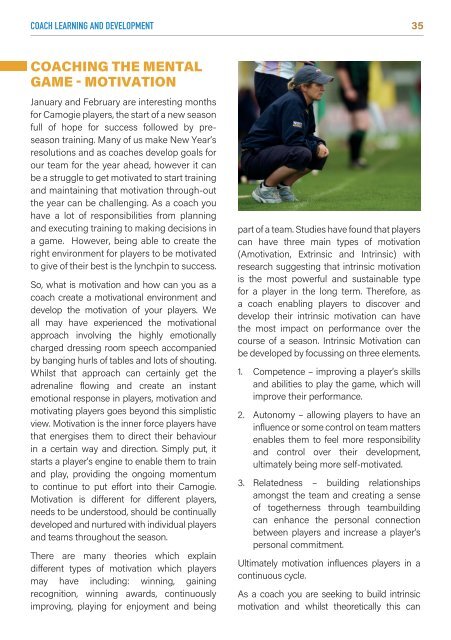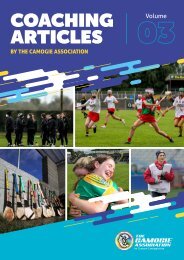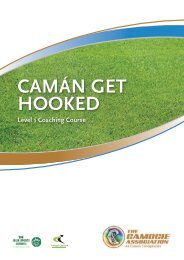Coach Learning and Development Booklet 2020
Camogie Coach Learning & Development Booklet
Camogie Coach Learning & Development Booklet
- No tags were found...
You also want an ePaper? Increase the reach of your titles
YUMPU automatically turns print PDFs into web optimized ePapers that Google loves.
<strong>Coach</strong> <strong>Learning</strong> <strong>and</strong> <strong>Development</strong> 35<br />
<strong>Coach</strong>ing the Mental<br />
Game - Motivation<br />
Reflection<br />
January <strong>and</strong> February are interesting months<br />
for Camogie players, the start of a new season<br />
• What happened<br />
full of hope for success followed by preseason<br />
training. Many of us make New Year’s<br />
• Evaluation<br />
• Analysis<br />
resolutions <strong>and</strong> as<br />
• Conclusion<br />
coaches develop goals for<br />
our team for the year ahead, however it can<br />
be a struggle to get motivated to start training<br />
<strong>and</strong> maintaining that motivation through-out<br />
the year can be challenging. As a coach you<br />
have a lot of responsibilities from planning<br />
<strong>and</strong> executing training to making decisions in<br />
a game. However, being able to create the<br />
right environment for players to be motivated<br />
to give of their best is the lynchpin to success.<br />
So, what is motivation <strong>and</strong> how can you as a<br />
coach create a motivational environment <strong>and</strong><br />
develop the motivation of your players. We<br />
all may have experienced the motivational<br />
approach involving the highly emotionally<br />
charged dressing room speech accompanied<br />
by banging hurls of tables <strong>and</strong> lots of shouting.<br />
Whilst that approach can certainly get the<br />
adrenaline flowing <strong>and</strong> create an instant<br />
emotional response in players, motivation <strong>and</strong><br />
motivating players goes beyond this simplistic<br />
view. Motivation is the inner force players have<br />
that energises them to direct their behaviour<br />
in a certain way <strong>and</strong> direction. Simply put, it<br />
starts a player’s engine to enable them to train<br />
<strong>and</strong> play, providing the ongoing momentum<br />
to continue to put effort into their Camogie.<br />
Motivation is different for different players,<br />
needs to be understood, should be continually<br />
developed <strong>and</strong> nurtured with individual players<br />
<strong>and</strong> teams throughout the season.<br />
There are many theories which explain<br />
different types of motivation which players<br />
may have including: winning, gaining<br />
recognition, winning awards, continuously<br />
improving, playing for enjoyment <strong>and</strong> being<br />
part of a team. Studies have found that players<br />
can have three main types of motivation<br />
(Amotivation, Extrinsic <strong>and</strong> Intrinsic) with<br />
research suggesting that intrinsic motivation<br />
is the most powerful <strong>and</strong> sustainable type<br />
for a player in the long term. Therefore, as<br />
a coach enabling players to discover <strong>and</strong><br />
develop their intrinsic motivation can have<br />
the most impact on performance over the<br />
course of a season. Intrinsic Motivation can<br />
be developed by focussing on three elements.<br />
1. Competence – improving a player’s skills<br />
<strong>and</strong> abilities to play the game, which will<br />
improve their performance.<br />
2. Autonomy – allowing players to have an<br />
influence or some control on team matters<br />
enables them to feel more responsibility<br />
<strong>and</strong> control over their development,<br />
ultimately being more self-motivated.<br />
3. Relatedness – building relationships<br />
amongst the team <strong>and</strong> creating a sense<br />
of togetherness through teambuilding<br />
can enhance the personal connection<br />
between players <strong>and</strong> increase a player’s<br />
personal commitment.<br />
Ultimately motivation influences players in a<br />
continuous cycle.<br />
As a coach you are seeking to build intrinsic<br />
motivation <strong>and</strong> whilst theoretically this can











